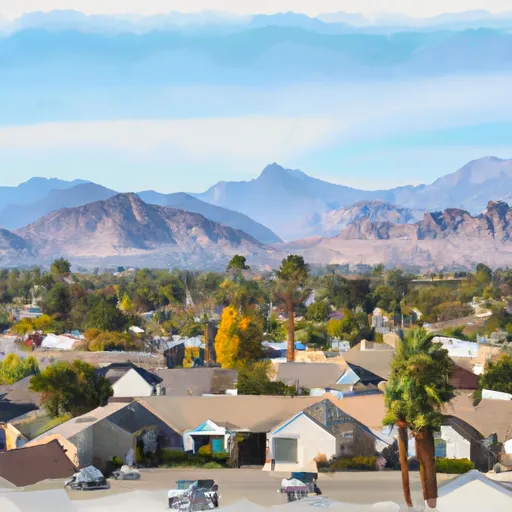-
 Snoflo Premium
Snoflo Premium
Get unlimited access to all our content
With no Ad interruptions! - Start Your Free Trial Login with existing account
Indian-Wells
Eden Index
Climate
7.5
•
Recreation
5.3
•
Community
3.0
•
Safeguard
5.6/10

Indian Wells is a picturesque city located in Riverside County, California. Known for its desirable climate, it experiences a hot desert climate with long, scorching summers and mild winters. Summers are characterized by temperatures reaching highs of around 110°F, while winters stay pleasant with temperatures averaging between 70-80°F.
In terms of hydrology, Indian Wells lies within the Coachella Valley, which is part of the Colorado Desert. The area is predominantly arid with limited surface water. However, the region benefits from the Coachella Valley Aquifer, which serves as the primary source of water for local residents and agriculture.
Outdoor enthusiasts can take advantage of various recreational opportunities in Indian Wells. Golf enthusiasts will be pleased to find numerous world-class golf courses, including the Indian Wells Golf Resort, which hosts the prestigious PGA Tour event, the Desert Classic. Hiking and biking trails can be found in nearby Joshua Tree National Park, offering breathtaking desert landscapes. Indian Wells also boasts luxurious resorts with swimming pools, tennis courts, and spas, providing relaxation and indulgence for visitors.
What is the Eden Index?
The Snoflo Eden Index serves as a comprehensive rating system for regions, evaluating their desirability through a holistic assessment of climate health, outdoor recreation opportunities, and natural disaster risk, acknowledging the profound impact of these factors on livability and well-being.
Climate Health Indicator (CHI): 7.5
Indian-Wells receives approximately
125mm of rain per year,
with humidity levels near 74%
and air temperatures averaging around
22°C.
Indian-Wells has a plant hardyness factor of
9, meaning
plants and agriculture in this region tend to thrive here all year round.
By considering the ideal temperature range, reliable water supplies, clean air, and stable seasonal rain or snowpacks, the Climate Health Indicator (CHI) underscores the significance of a healthy climate as the foundation for quality living.
A healthy climate is paramount for ensuring a high quality of life and livability in a region, fostering both physical well-being and environmental harmony. This can be characterized by ideal temperatures, reliable access to water supplies, clean air, and consistent seasonal rain or snowpacks.
Weather Forecast
Streamflow Conditions
Salton Sea
Area Rivers
Salton Sea
Snowpack Depths
Salton Sea
Reservoir Storage Capacity
Salton Sea
Groundwater Levels
Recreational Opportunity Index (ROI): 5.3
The Recreational Opportunity Index (ROI) recognizes the value of outdoor recreational options, such as parks, hiking trails, camping sites, and fishing spots, while acknowledging that climate plays a pivotal role in ensuring the comfort and consistency of these experiences.
Access to outdoor recreational opportunities, encompassing activities such as parks, hiking, camping, and fishing, is crucial for overall well-being, and the climate plays a pivotal role in enabling and enhancing these experiences, ensuring that individuals can engage in nature-based activities comfortably and consistently.
Camping Areas
| Campground | Campsites | Reservations | Toilets | Showers | Elevation |
|---|---|---|---|---|---|
| Pinyon Flat | 18 | 4,026 ft | |||
| Hidden Valley - Joshua Tree National Park | 44 | 4,222 ft | |||
| Borrego Palm Canyon - Anza Borrego Desert State Park | 117 | 749 ft | |||
| Indian Cove - Joshua Tree National Park | 101 | 3,224 ft | |||
| Ryan - Joshua Tree National Park | 31 | 4,319 ft | |||
| Lake Cahuilla County Park | 56 | 2 ft | |||
| Black Rock - Joshua Tree National Park | 100 | 3,962 ft | |||
| Rockhouse Canyon Rd Dispersed | None | 639 ft |
Catastrophe Safeguard Index (CSI):
The Catastrophe Safeguard Index (CSI) recognizes that natural disaster risk, encompassing floods, fires, hurricanes, and tornadoes, can drastically affect safety and the overall appeal of an area.
The level of natural disaster risk in a region significantly affects safety and the overall livability, with climate change amplifying these risks by potentially increasing the frequency and intensity of events like floods, fires, hurricanes, and tornadoes, thereby posing substantial challenges to community resilience and well-being.
Community Resilience Indicator (CRI): 3.0
The Community Resilience Indicator (CRI) recognizes that education, healthcare, and socioeconomics are crucial to the well-being of a region. The CRI acknowledges the profound impact of these elements on residents' overall quality of life. By evaluating educational resources, healthcare accessibility, and economic inclusivity, the index captures the essential aspects that contribute to a thriving community, fostering resident satisfaction, equity, and social cohesion.

